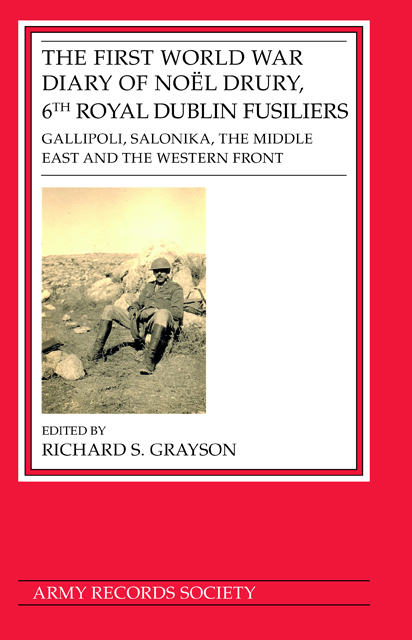 First World War Diary of Noël Drury, 6th Royal Dublin Fusiliers
First World War Diary of Noël Drury, 6th Royal Dublin Fusiliers Book contents
- Frontmatter
- Miscellaneous Frontmatter
- Contents
- List of Illustrations
- Acknowledgements
- List of Abbreviations
- Introduction
- 1 Volunteering and Training, September 1914–July 1915
- 2 The Voyage to the Dardanelles, July–August 1915
- 3 Gallipoli: Landing at Suvla Bay and the Next Ten Days, 7–17 August 1915
- 4 Gallipoli: Digging In, 18 August–October
- 5 The Serbian Front and the Battle of Kosturino, October–December 1915
- 6 The Salonika Front and Hospital, December 1915–September 1917
- 7 Egypt and Palestine, September–December 1917
- 8 Defending Jerusalem and the Battle of Tell ‘Asur, December 1917–July 1918
- 9 France, July–11 November 1918
- 10 Armistice, 12 November 1918– 11 March 1919
- Appendix 1 6th Royal Dublin Fusiliers leaving home for service overseas, 10 July 1915
- Appendix 2 The Effects of the Gallipoli Campaign on the 6th Royal Dublin Fusiliers
- Appendix 3 Officers of the 6th Royal Dublin Fusiliers at Hastière-sur-Meuse, Nov 1918
- Biographies
- Bibliography
- Index
5 - The Serbian Front and the Battle of Kosturino, October–December 1915
Published online by Cambridge University Press: 14 June 2023
- Frontmatter
- Miscellaneous Frontmatter
- Contents
- List of Illustrations
- Acknowledgements
- List of Abbreviations
- Introduction
- 1 Volunteering and Training, September 1914–July 1915
- 2 The Voyage to the Dardanelles, July–August 1915
- 3 Gallipoli: Landing at Suvla Bay and the Next Ten Days, 7–17 August 1915
- 4 Gallipoli: Digging In, 18 August–October
- 5 The Serbian Front and the Battle of Kosturino, October–December 1915
- 6 The Salonika Front and Hospital, December 1915–September 1917
- 7 Egypt and Palestine, September–December 1917
- 8 Defending Jerusalem and the Battle of Tell ‘Asur, December 1917–July 1918
- 9 France, July–11 November 1918
- 10 Armistice, 12 November 1918– 11 March 1919
- Appendix 1 6th Royal Dublin Fusiliers leaving home for service overseas, 10 July 1915
- Appendix 2 The Effects of the Gallipoli Campaign on the 6th Royal Dublin Fusiliers
- Appendix 3 Officers of the 6th Royal Dublin Fusiliers at Hastière-sur-Meuse, Nov 1918
- Biographies
- Bibliography
- Index
Summary
The 6th Royal Dublin Fusiliers arrived in Mudros Bay on 2 October 1915 and spent a few days there until it became clear that they would be deployed to Salonika to fight the Bulgarian forces who were attacking Serbian territory. After being courted by both the Allies and the Central Powers through 1915, it became apparent in September 1915 that Bulgaria would soon join the war on the side of the latter. Serbia had repelled Austro-Hungarian attacks in the early months of war, but by the autumn of 1915 they were facing a stronger combination of forces. Germany and Austria-Hungary launched an assault against Serbia on 7 October 1915, and it looked likely that Bulgaria would soon join the offensive, which it did on 14 October. Serbia's army retreated through Montenegro and Albania to Greece, as Serbia was occupied by its enemies. A request from both Serbia and from neutral Greece, which had treaty obligations to Serbia, for allied troops in early October 1915 was met with the dispatch of British and French soldiers from Gallipoli. Initially composed of 13,000 British and 18,000 French, the Salonika force would rise to 300,000 with the allies there until the end of the war. The territory in which they fought was then widely referred to as ‘Macedonia’ but strictly contained two areas: the territories of northern Greece which used that label and the country now internationally recognised as the ‘Republic of North Macedonia’. The latter was ruled as part of Serbia prior to the First World War, and it was there – in what was known as the ‘Macedonian Front’ – that fighting took place between British/French and Bulgarian forces as the latter continued to pursue the Serbian army in the final months of 1915.
Parts of the 10th (Irish) Division were among the first British forces to arrive in Salonika on 5 October. The 6th Royal Dublin Fusiliers boarded their transport at Mudros that day and were due to leave on 6 October, but their ship became entangled with anti-submarine nets and they did not depart until the evening of the 9 October, arriving at Salonika the next day. Drury reflected, ‘I think we will probably get it in the neck, as they [the Bulgarians] are all fresh and ready, while our fellows are worn out and tired.
- Type
- Chapter
- Information
- First World War Diary of Noël Drury, 6th Royal Dublin FusiliersGallipoli, Salonika, the Middle East and the Western Front, pp. 95 - 143Publisher: Boydell & BrewerPrint publication year: 2022


